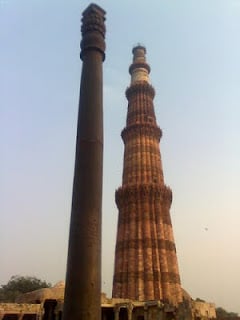
Here is another monument which was shell-cased, desecrated, manipulated and renamed to suit personal/religious agendas.
It is a long article/post but it touches all basis and leaves no stone unturned. If you are interested in this subject matter then please read completely! I can assure you that you won’t be disappointed.
PART 1 – ARTICLE BY PROF. M.S. BHATNAGAR
PART 2 – IT’S ORIGIN AND VERY IMPORTANT DETAILS.
BTW, DID YOU KNOW?
In Arabic “Qutub” literally means ‘axis’, ‘pivot’ or ‘pole’. Qutb can refer to celestial movements and used as an astronomical term or a spiritual symbol. So the term ‘Qutub Minar’ signifies an astronomical Tower. That was how it was described to Sultan and later referred to in court correspondence. In course of time the name of Sultan Qutubuddin came to be unwittingly associated with the Qutub Tower leading to the misleading assertion that Qutubuddin built the Qutub Minar.
PART 1.
– by Prof. M.S. Bhatnagar, Ghaziabad (India)
June 10, 1977
This unique and unprecedented diagram (Fig 1) is that of the so-called QUTB MINAR. It uncovers the truth and knocks out all confusing, contradictory and fabricated explanations given by chroniclers of the Moslem Kings of Delhi and some archaeologists about the history and purpose of this lofty stone-tower.
A visit which fostered the present research :
In 1961, some college students went with me to the Qutb Minar and engaged an official guide, an M.A. in History. Questions and answers between our party and the Sarkari guide are given below in brief :-
Q. What was the purpose of building this ‘MINAR’ ?
A. Victory Tower.
Q. Whose victory over whom ?
A. Md. Ghori’s victory over Rai Pithaura (Prithvi Raj)
Q. Where ?
A. At Tarain near Panipat.
Q. Why is the Victory Tower at Delhi ?
A. Do not know.
One gentleman from the visitors, a Lecturer in History in the University of Delhi, took up the threat and answered:
The Victory Tower was commenced by Ghori because Delhi became his capital.
Q. Objection, Sir! Ghori never had his capital at Delhi. His capital was at Ghazni. What logic is there in building the Victory Tower in Delhi ?
A. Silence.
Q. Even if the Minar was commenced by Ghori, its name ought to have been ‘GHORI MINAR’ and not ‘QUTB MINAR’. Why is it called ‘Qutb Minar’ ?
A. It was probably Qutubuddin Aibak, slave of Ghori, who laid the foundation of the minar for his master.
Q. If this is true, what made him choose Delhi as the site for the Victory Tower?
A. Delhi was the capital of Qutbuddin Aibak.
Q. It is said that the building of the Minar was commenced during the life time of Ghori. When Ghori was alive, the question of his slave’s capital being at Delhi does not arise. After the death of Ghori, Qutbuddin was crowned at Sultan at Lahore. He ruled from Lahore and not Delhi and ultimately died at Lahore. His capital was at Lahore ? Why did he build the Victory Tower at Delhi ?
A. Silence.
Somebody from the audience asserted that the Minar was not a victory tower but a ‘Mazina’ (Muezzin’s Tower in mosque) attached to ‘Quwwat-ul-Islam Mosque’.
Q. The word ‘Quwwat-ul-Islam Mosque’ is unknown to contemporary history of India. This word was coined by Sir Saiyid Ahmad Khan in the first part of the nineteeth century. Do not be surprised to know that the name ‘QUTB MINAR’ too, is not known to Indian History. It is also a recent fabrication. If, for the sake of argument, we take it for granted that the minar is a muezzin’s tower, the mosque assumes primary importance and the tower secondary, but unfortunately the mosque, as you see it, is in complete ruins. How do you account for the mosque of primary importance to be in ruins and the muezzin’s tower, a building of no consequence, to be standing in full majesty ?
A. No Answer.
‘Masjid & Mazina’ with regard to the Qutb Minar is a “COCK & BULL STORY”. The so called Qutb Minar and the ruined Jama Masjid close by cannot be ascribed to the same builder. The Qutb Minar is a much older tower.
Quranic inscriptions on the Minar
The Quranic inscriptions on the Minar are forced and lifeless insertions between forceful and beautiful frieze-bands of the pure HINDU DESIGN. To consider the minar of Moslem origin from the Quranic inscriptions would be labelling a non-Muslim as a Mussalman because circumcision has been forced on him.
The Dhruv Stambha
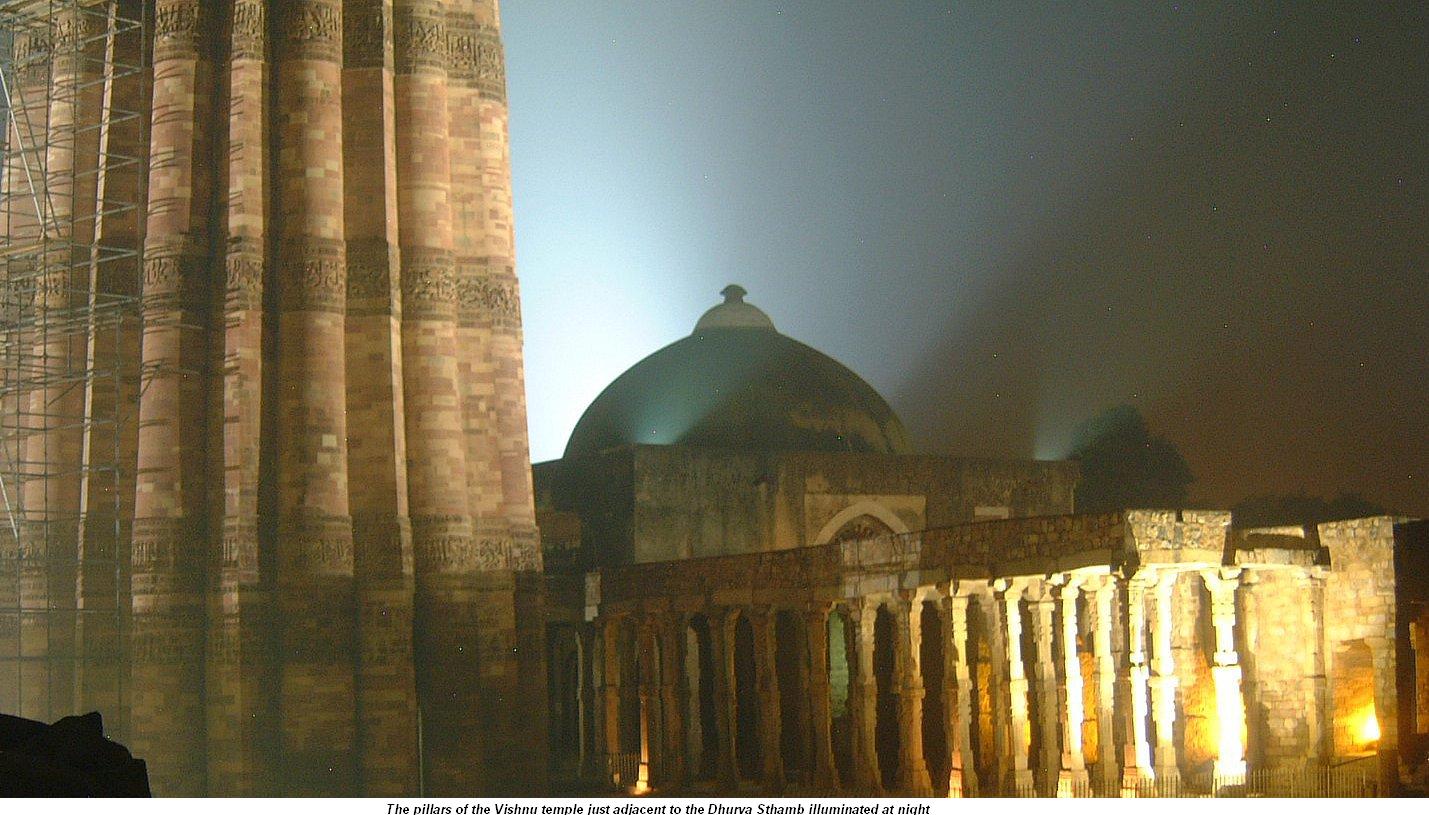
The Minar is in fact the Dhurva Stambha or the central observation tower of an ancient Hindu Astronomical Observatory. Fig. 1 is based on observation from a two seater aeroplane made to hover over the top of the DHRUVA STAMBHA. The tower looks like a 24-petalled lotus flower (Fig. 2), each petal representing an “HORA”, i.e., an hour on a 24-hour dial (Fig. 3). Vertical projection lines drawn from the mid points of stone-flutings on the top of each storey of the tower to the horizontal plane at its base create a lotus flower similar to what can be seen from the sky over the top of the tower – bottom fig. 1. (Note : Please refer below scanned pages for reference of figures mentioned in this paragraph)
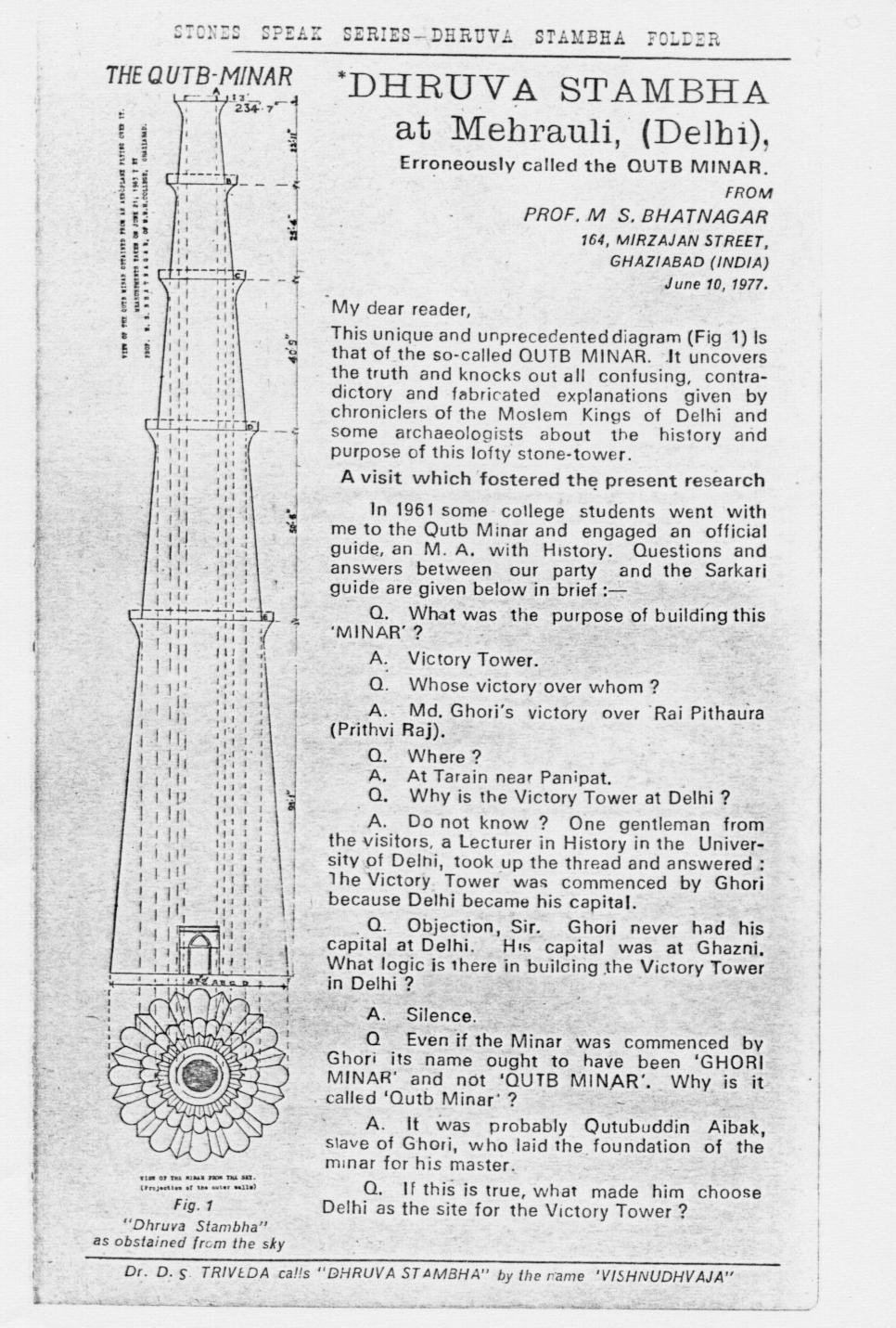
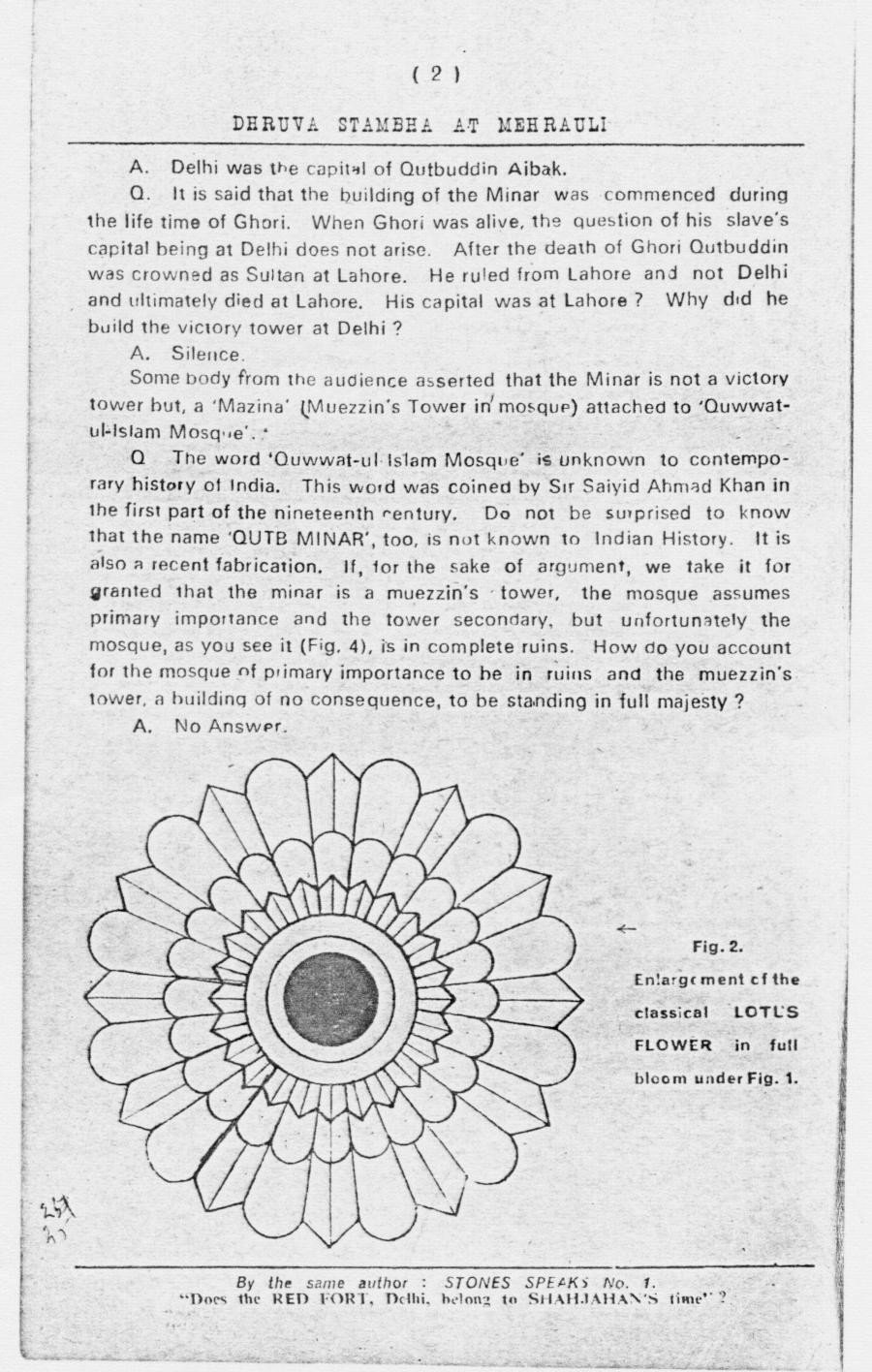
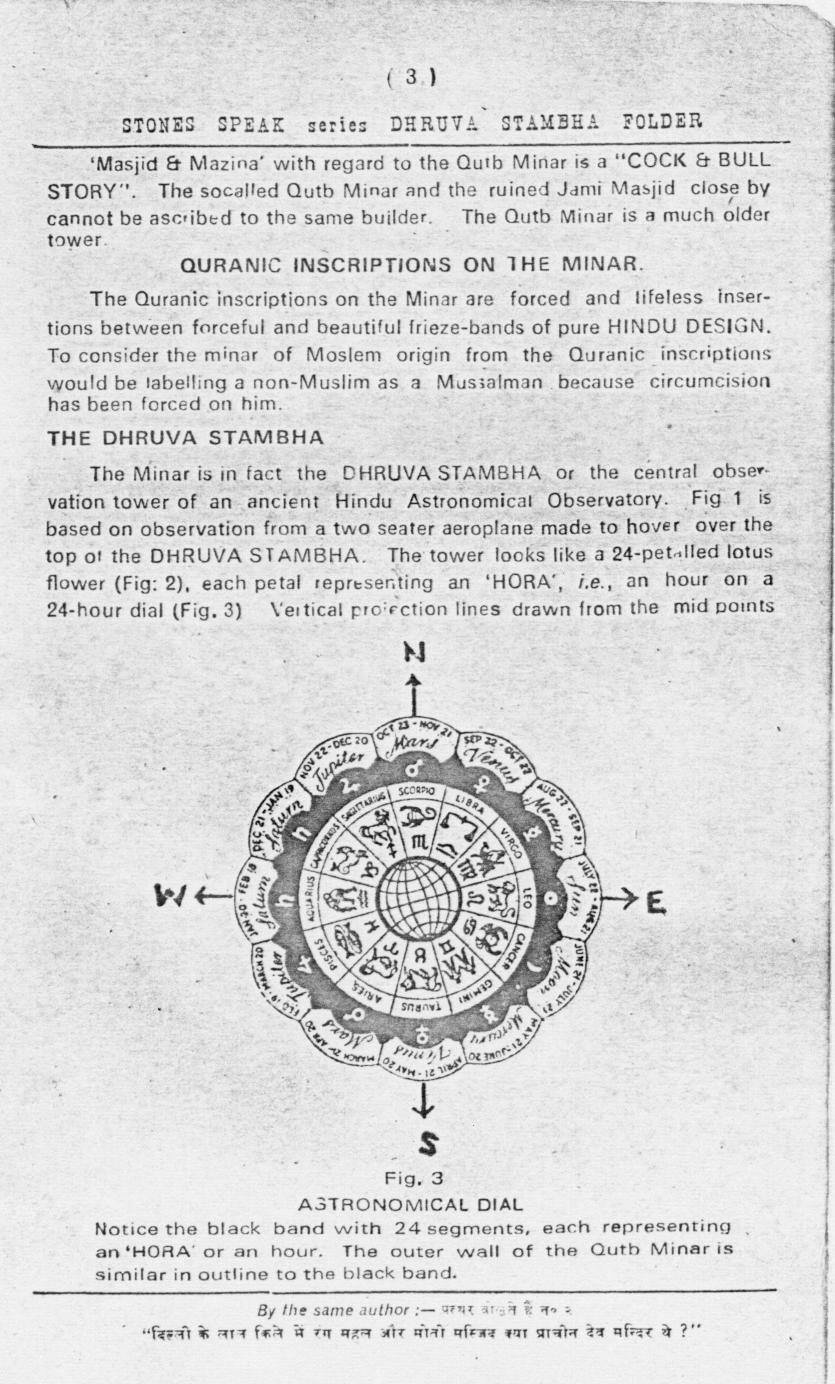
The 24-petalled architectural lotus flower is purely a Hindu concept. It cannot be attributed to any Moslem king from dry parts of Western Asia where lotuses do not grow.
You are the proud possessor of the ‘LOTUS’ projection of the DHRUVA STAMBHA which is the result of original thinking, perseverance and expense. Such a projection was neither drawn nor conceived by any architect or archaeologist in the past. Let any body come forward and challenge the statement. Now, you can reasonably silence all those who believe the DHRUVA STAMBHA to be a production of Md. Ghori or Qutbuddin Aibak. Sultans associated with this ‘Minar’ defiled its casing, reversed stones bearing human or animal figures and inserted Arabic Inscriptions. These Sultans can, of course, be praised for not making any claim that they built the ‘Minar’. No body has left any inscription asserting that he started the Minar.
PART 2 : Its origins
About the Qutub Minar itself there is overwhelming proof that it was a Hindu tower existing hundreds of years before Qutubuddin and therefore it is wrong to ascribe the tower to Qutubuddin.
The township adjoining the Qutub Minar is known as Mehrauli. That is a Sanskrit word Mihira-awali. It signifies the township where the well known astronomer Mihira of Vikramaditya’s court lived along with his helpers, mathematicians and technicians. They used the so-called Qutub tower as an observation post for astronomical study. Around the tower were pavilions dedicated to the 27 constellations of the Hindu Zodiac.
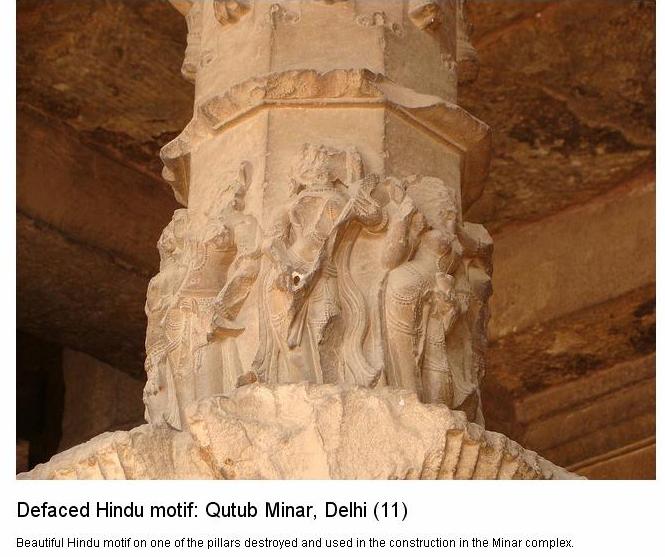
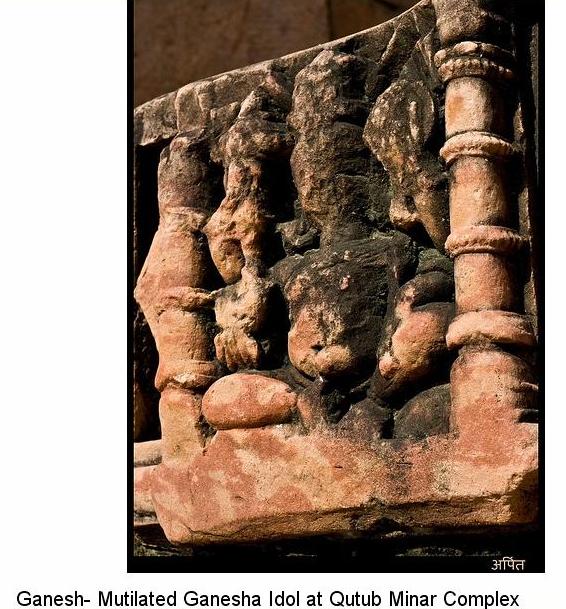
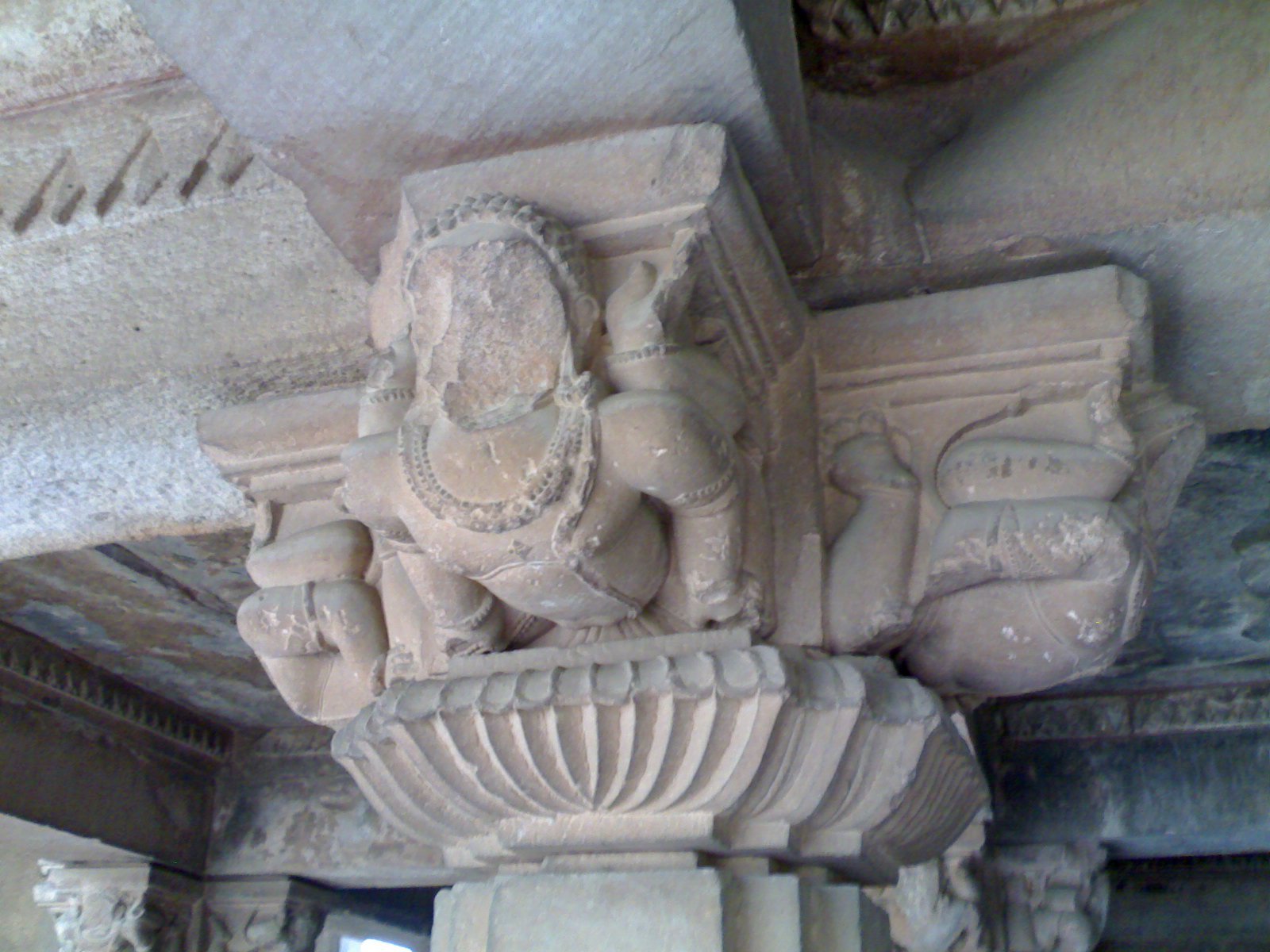
Qutubuddin has left us an inscription that he destroyed these pavilions. But he has not said that he raised any tower. The ravaged temple was renamed as Kuwat-ul-Islam mosque.
Stones dislodged from the so-called Qutub Minar have Hindu images on one side with Arabic lettering on the other. Those stones have now been removed to the Museum. They clearly show that Muslim invaders used to remove the stone- dressing of Hindu buildings, turn the stones inside out to hide the image facial and inscribe Arabic lettering on the new frontage.
Bits of Sanskrit inscriptions can still be deciphered in the premises on numerous pillars and walls. Numerous images still adorn the cornices though disfigured.
The tower is but a part of the surrounding structures. It is not that while the temples around are earlier Hindu buildings there was sufficient space left in between for Qutubuddin to come and build a tower. Its very ornate style proves that it is a Hindu tower. Mosque minarets have plane surfaces. Those who contend that the tower was meant to call the Muslim residents to prayer have perhaps never tried to go to the top and try to shout to the people below. Had they done so they would have found out for themselves that no one on the ground can hear them from that height. Such absurd claims have been made to justfy Muslim authorship of earlier Hindu buildings.
Another important consideration is that the entrance to the tower faces north and not the west as is enjoined by Islamic theology and practice.
At either side of the entrance is the stone lotus flower emblem which also proves that it was a Hindu building. The stone flowers are a very important sign of the Hindu author- ship of mediaeval buildings. Muslims never use such flowers on the buildings they construct.
The frieze Patterns on the tower show signs of tampering, ending abruptly or in a medley of incongruent lines. The Arabic lettering is interspersed with Hindu motifs like lotus buds hanging limp. Sayyad Ahmad Khan, a staunch Muslim and a scholar, has admitted that the tower is a Hindu building.
If one were to hoover in an aeroplane over the top of the tower the various galleries sliding into each other from top to bottom appear like a 24-petal lotus in full bloom. The figure 24 being a multiple of 8 is sacred in Vedic tradition. Even the brick red colour of the tower is sacred to the Hindus.
The Hindu title of the tower was Vishnu Dhwaj (i.e. Vishnu’s standard) alias Vishnu Stambh alias Dhruv Stambh (i.e., a polar pillar) obviously connoting an astronomical observation tower. The Sanskrit inscription in Brahmi script on the non-rusting iron pillar close by proclaims that the lofty standard of Vishnu was raised on the hillock named Vishnupad Giri. That description indicates that a statue of the rec- lining Vishnu initiating the creation was consecrated in the central shrine there which was ravaged by Mohammad Ghori and his henchman Qutubuddin. The pillar was raised at the command is an ancient Hindu king who had made great conquests in the East and the West.
The tower had seven storeys representing the week of those only five exist now. The sixth was dismantled, hauled down and re-erected on the lawns closeby.
The seventh storey had actually a statue of the four-faced Brahma holding the Vedas at the beginning of creation. Above Brahma was a white marble canopy with gold bell patterns laid in it. The t top three stories were in mle. They were ravaged by iconoclastic muslims who detested the Brahma statue. The Muslim raiders also destroyed the reclining Vishnu image at the bottom.
The iron pillar was the Garud Dhwaj alias Garud Stambh, i.e, the sentinel post of the Vishnu temple.
On one side was an elliptical enclave formed by 27 Nakshatra (constellation) temples. A gigantic red-stone, ornate gate- way led to the sacred enclave known as Nakshatralaya. Therefore gateway is traditionally known as Alaya-Dwar.
Cunningham twists the traditional Hindu name to fraudulently ascribe the great doorway to Sultan Allauddin though Allauddin himself makes no such claim.
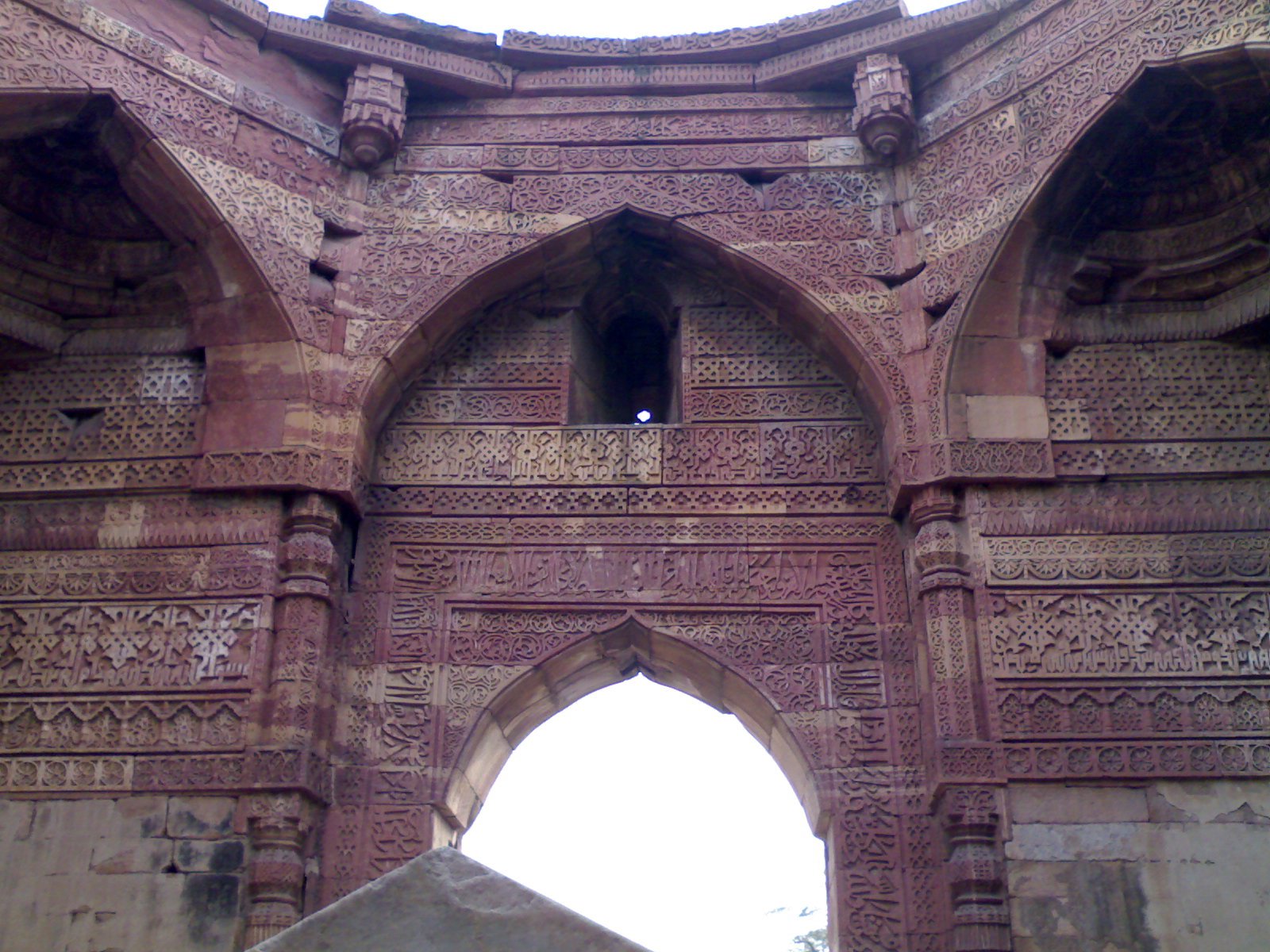
By Allauddin’s time the surroundings were totally crumbling ruins. Why would Allauddin want to raise an ornate gigantic gateway (of the Hindu orange colour) leading from nowhere to nowhere ?
The theory propounded by interested Muslims that it is a muazzin’s tower is a motivated lie. No muazzin would even for a day adept a job where he has to climb and unclimb five times a day a flight of 365 narrowing, curving steps in the dark confines of the tower. He is bound to fall and die through sheer exhaustion.
The arched gateway of the adjoining so-called Kuwat-ul-Islam mosque is in no way different from the ornate archways of temples in Gujarat. The frieze patterns on this building too. The frieze patterns on this building too show signs of tampering proving that Muslim conquerors transposed stones at random to ease their conscience in readying earlier temples for use as mosques.
The tower girth is made up of exactly 24 folds, arcs and triangles alternating. This shows that the figure 24 had social prominence and significance in the premises. The apertures for letting in light are 27. Considered along with the 27 constellation pavilions mentioned earlier it leaves no doubt that the tower too was an astronomical observation pole.
In Arabic the term ‘Qutub Minar’ signifies an astronomical Tower. That was how it was described to Sultan and later referred to in court correspondence. In course of time the name of Sultan Qutubuddin came to be unwittingly associated with the Qutub Tower leading to the misleading assertion that Qutubuddin built the Qutub Minar.
Iron strips have been used to keep the huge boulders fastened together in the construction of the tower. Similar strips have been used in the stone walls of Agra Fort. In my book Tajmahal was a Rajput Palace I have already dealt at some length on the origin of the fort and proved that it existed during pre-muslim times. Therefore it is apparent that the use of iron strips to keep together stones in huge buildings was a Hindu device. That device used in the so-called Qutub Minar in Delhi another proof of its having been a pre-Muslim Hindu tower. If a 24-petal lotus is pulled up from its centre it will form a tower of that pattern. Lotus pattern is never Muslim.
Source : 1. Sanskriti Magazine 2. Hindunet.org






Started By The Mughals, Carry forwarded by the Britishers and than by Nehru-Gandhi Family… Hope Modi Sarkar can stop this Distortion and bring back the actual glory of Sanatan Dharma.
First of all we have to ban the books printed giving the false information to our new / young generation and take necessary steps to acquire Bharathiy sampadh.
This is the Jaan jagruti, now let us make it internationally that all monuments in India belonged to Hindus and was taken forcefully by the Muslims. We should change the names and produce new history books with reality. Jai hind.
If India was not divided.what would be the situation(of undivided India. including Pakistan and Bangaladesh) to-day?Can anyone describe?
These Ghazni & Goris’ leftover must be shipped out of this country. It is an unfinished business of 1947 partition. They parasites feeding on us and causing impediment to our country’s progress.
These Ghazni & Goris’ leftover must be shipped out of this country. It is an unfinished business of 1947 partition. They par*sites feeding on us and causing impediment to our country’s progress.
This is absolutely right i have taken some pics from the site and found the same facts as mentioned above how can we take it forward from here.